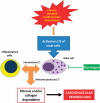Cardiac mast cells: the centrepiece in adverse myocardial remodelling
- PMID: 20736239
- PMCID: PMC3002871
- DOI: 10.1093/cvr/cvq272
Cardiac mast cells: the centrepiece in adverse myocardial remodelling
Abstract
Increased numbers of mast cells have been reported in explanted human hearts with dilated cardiomyopathy and in animal models of experimentally induced hypertension, myocardial infarction, and chronic volume overload secondary to aortocaval fistula and mitral regurgitation. Accordingly, mast cells have been implicated to have a major role in the pathophysiology of these cardiovascular disorders. In vitro studies have verified that mast cell proteases are capable of activating collagenase, gelatinases and stromelysin. Recent results have shown that with chronic ventricular volume overload, there is an elevation in mast cell density, which is associated with a concomitant increase in matrix metalloproteinase (MMP) activity and extracellular matrix degradation. However, the role of the cardiac mast cell is not one dimensional, with evidence from hypertension and cardiac transplantation studies suggesting that they can also assume a pro-fibrotic phenotype in the heart. These adverse events do not occur in mast cell deficient rodents or when cardiac mast cells are pharmacologically prevented from degranulating. This review is focused on the regulation and dual roles of cardiac mast cells in: (i) activating MMPs and causing myocardial fibrillar collagen degradation and (ii) causing fibrosis in the stressed, injured or diseased heart. Moreover, there is strong evidence that premenopausal female cardioprotection may at least partly be due to gender differences in cardiac mast cells. This too will be addressed.
Figures

References
-
- Theoharides TC, Kempuraj D, Tagen M, Conti P, Kalogeromitros D. Differential release of mast cell mediators and the pathogenesis of inflammation. Immunol Rev. 2007;217:65–78. doi:10.1111/j.1600-065X.2007.00519.x. - DOI - PubMed
-
- Okayama Y, Kawakami T. Development, migration, and survival of mast cells. Immunol Res. 2006;34:97–115. doi:10.1385/IR:34:2:97. - DOI - PMC - PubMed
-
- Rodewald HR, Dessing M, Dvorak AM, Galli SJ. Identification of a committed precursor for the mast cell lineage. Science. 1996;271:818–822. doi:10.1126/science.271.5250.818. - DOI - PubMed
-
- Chen CC, Grimbaldeston MA, Tsai M, Weissman IL, Galli SJ. Identification of mast cell progenitors in adult mice. Proc Natl Acad Sci USA. 2005;102:11408–11413. doi:10.1073/pnas.0504197102. - DOI - PMC - PubMed
-
- Arinobu Y, Iwasaki H, Gurish MF, Mizuno S, Shigematsu H, Ozawa H, et al. Developmental checkpoints of the basophil/mast cell lineages in adult murine hematopoiesis. Proc Natl Acad Sci USA. 2005;102:18105–18110. doi:10.1073/pnas.0509148102. - DOI - PMC - PubMed

